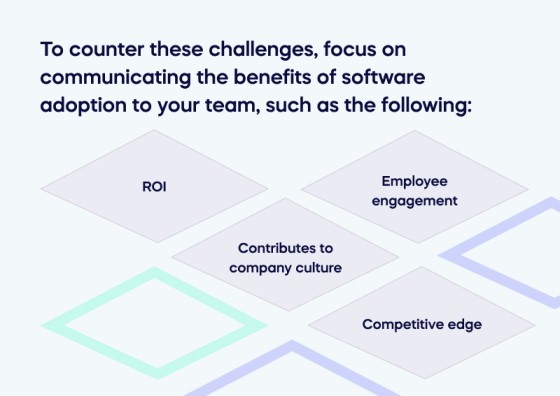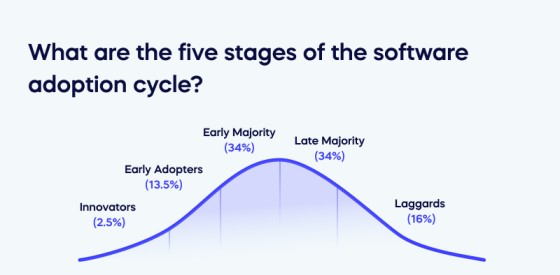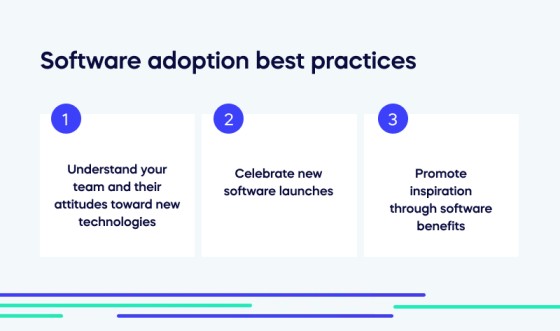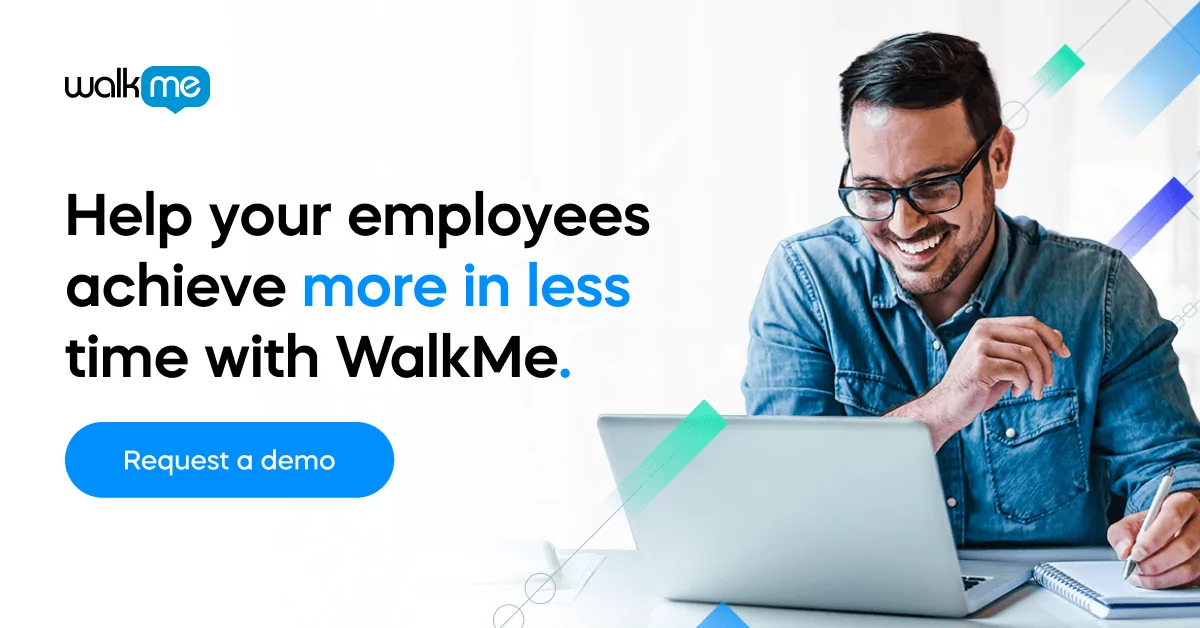What’s the point of investing hundreds of thousands in new software if your staff doesn’t use it?
Many organizations ask themselves this question yearly as they invest, on average, USD 234 million into their digital transformations but often fail to reach strategic goals due to weak software adoption.
This statistic shows how challenging it can be for 2023 to adopt new software solutions because organizations ask their employees to use many software solutions simultaneously.
But there are best practices to increase adoption rates by focusing on the software adoption process and supporting your staff to understand why new technologies are needed.
To help you understand the importance of software adoption and allow you to streamline your road to adoption success, we will explore the following topics:
- What is software adoption in 2023?
- What is the significance of software adoption in 2023?
- What is the software adoption cycle?
- Software adoption strategies
- 3 software adoption success stories
What is software adoption in 2023?
Software adoption in 2023 is staff learning and being motivated to use software, so they make it part of their daily workflow.
Help your staff to achieve software adoption by guiding their understanding of the need for the new software implementation and how it can help them do their job more efficiently, making their lives easier.
Doing so will motivate them to become cheerleaders for your software adoption strategy.
What is the significance of software adoption in 2023?
In 2023, there are so many software solutions and mobile apps that staff often get overwhelmed, and staff often meet emails about yet another new app with sighs than smiles.
Despite these challenges, staff must adopt new software solutions, so it’s essential to consider how to support your team by understanding their software adoption pain points, which often include resistance to change and fear that new solutions will lead to dismissals.

To counter these challenges, focus on communicating the benefits of software adoption to your team, such as the following:
- ROI: High adoption rates mean a more efficient and higher ROI.
- Employee engagement: When employees engage with new technologies, their engagement with their organization increases as they understand the importance of new software solutions to organizational success.
- Contributes to company culture: A culture of successful software adoption is a culture of embracing change and high digital resilience.
- Competitive edge: Using new technologies gives you an edge against competitors as the need to succeed begins to drive software adoption.
What are the five stages of the software adoption cycle?

The software adoption lifecycle stages categorize users into five groups based on their willingness and speed to adopt a new piece of software compared to the general population.
We can adapt the Rogers digital adoption curve to software adoption as we place each of the five groups on the angle according to their percentage of users.
IMAGE
1. Innovators (2.5%)
Software adopters open to trying and using new products are considered innovators. They tend to be the younger members of your workforce, with more financial freedom, and stay up-to-date with innovative sources, like entrepreneurs.
2. Early Adopters (13.5%)
Early adopters comprise just over 10% of the population and are the next group to embrace new technology products. They are typically younger, have greater financial flexibility, and have a higher level of education than late adopters.
They are also considered “influencers” or opinion leaders. Look out for members of your workforce who use social media a lot to influence the views of others on new technologies and social trends. This group is the best one to target as champions of software adoption, encouraging others to adopt new technologies in exciting new ways.
Although they are very interested in innovations in the market, they are more selective than innovators when making purchase decisions.
3. Early Majority (34%)
The early majority, which represents half of the bell curve, tends to be more cautious and less willing to take risks regarding financial investments. They rely on feedback from influencers and early adopters and conduct thorough research before making decisions.
The early majority are likely to be young members of your workforce with small children. They are still relatively young but beginning to be more financially careful and considerate of the future, influencing their adoption of new technologies.
Although not as enthusiastic as early adopters, they are more active than the late majority and laggards and play a crucial role in expanding a product’s market share.
4. Late Majority (34%)
The late majority tends to adopt an innovation after the average team member because they are usually more skeptical about its benefits and have less financial flexibility than earlier adopters.
Additionally, they often only engage with the early majority of team members, which signifies that a product has matured in the market. The late majority are at the peak of the software adoption curve.
5. Laggards (16%)
The ” Laggards ” group is the final stage in the technology adoption process. They resist change, and opinion leaders do not often easily influence them.
Laggards prioritize the reliability of their products and may not have much financial freedom to take chances on new products.
Additionally, they tend to rely on only their close friends and family for recommendations rather than influencers or those who adopt new products early.
Laggards are more likely to be older, more experienced members of your team. Ensure you work to encourage them to engage in software adoption, as they may lead to a regression of progress if they express their doubts to colleagues from other stages of the adoption curve.
Consider which of your staff fall into each software adoption stage and use this info to tailor your support to promote a successful software adoption process.
Software adoption best practices

Implement these software adoption best practices for adoption rate success and changes that stick for the long term.
Understand your team and their attitudes toward new technologies
Finding software that meets the needs of your users involves understanding them and creating appropriate copy, marketing campaigns, and onboarding flows to guide them through the various stages of adoption.
Follow these steps to promote a software adoption strategy for your team:
- Conduct market research and create an ideal customer profile (ICP) and buyer personas. If your business is B2B SaaS, create buyer personas for the various roles in the companies you want to target.
- During onboarding, it is essential to determine the activation criteria for various users and identify the point where they experience their ‘aha moment.’ This moment is when they first recognize the value, typically while completing a critical task.
- Evaluate the effectiveness of your website and marketing strategies by utilizing analytics tools for your website and email marketing, along with monitoring metrics for software adoption and KPIs.
Celebrate new software launches
To encourage employee engagement with new technology, why not team up with your marketing and PR department to arrange an event celebrating its launch? Both in-person and video conference attendance options will be available for team members.
When introducing new technology, people may be hesitant to adopt it. However, you can facilitate their success by organizing events to showcase its benefits and providing opportunities for training.
Promote inspiration through software benefits
Users must share their skills and knowledge to benefit from the technology entirely. The company’s adoption process should include informing users about the technology’s capabilities, purpose, and usage.
Sharing the success of a department’s use of new technology can inspire others to find innovative ways of using it, leading to an increase in potential ROI for your business.
To speed up the acceptance of new technology, consider utilizing a variety of training modules when introducing it.
3 software adoption success stories
The best way to get inspired and motivated for your software adoption efforts is to analyze the successes of other organizations. Let’s begin with one of the largest global tech organizations: IBM.
IBM

IBM has shifted from being a traditional tech leader to a cloud platform and cognitive solutions company providing various digital products.
They faced user abandonment issues in their groundbreaking B2B products due to weak onboarding experiences and limited support. Therefore, the company identified the need for a new digital adoption strategy to improve engagement and sales.
IBM improved user retention rates from 50% to over 70% using the WalkMe Digital Adoption Platform (digital adoption solutions) to assist with user onboarding and software feature adoption.
WalkMe’s in-app guidance provided an intuitive user experience, and IBM integrated WalkMe with essential applications, centralizing data and providing valuable insights into the customer journey.
Since implementing WalkMe, IBM has experienced a 300% improvement in product usage, consumption, and retention.
Nestlé

Nestlé has over 2,000 brands and 270,000 employees worldwide and is the world’s largest food and beverage company.
Like many other companies, Nestlé faced common obstacles while undergoing digital transformation, such as low app adoption rates, inefficient use of crucial apps, user fatigue, and the challenges associated with managing multiple systems.
Nestlé has made significant progress in its Digital Adoption Platform (DAP) journey in just two years. Using WalkMe analytics, Nestlé delivers digital adoption at scale and continuously enhances employee experience while achieving business results.
People Matter

PeopleMatter serves numerous industries, such as retail, restaurant, and service sectors. PeopleMatter expended significant resources on its support and training center to cater to diverse users with unique demands.
The company aimed to enhance the user experience, facilitate faster onboarding, and foster self-service support and software adoption.
PeopleMatter installed an app guidance tool called Smart Walk-Thrus by WalkMe as a core element of their software adoption. The tool only shows relevant support and training information to specific user groups to improve user adoption.
PeopleMatter has been adding more Walk-Thrus and advanced features from WalkMe since then. The support team received fewer user support inquiries since the partnership, and the user experience improved with faster user adoption and better efficiency.
Use a DAP to drive software adoption
The road to software adoption should never feel like a one-way street. With the help of a DAP, every stakeholder will have the support they need throughout the entire process, from planning to execution. Using a DAP ensures that all steps are taken with efficiency and organization to maximize success.
Software adoption no longer has to be an intimidating journey but rather a well-oiled machine that requires regular upkeep and maintenance.
When you incorporate a DAP into your software adoption process, you can feel confident that your road will always lead somewhere positive. So don’t leave it for another day – begin streamlining your path to success today!


